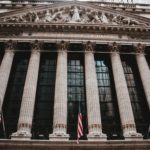The actions taken are not in chronological order. See this article for a timeline or this one.
I was sitting in 10th grade history class when the 2008 Financial Crisis hit its peak, culminating in a 20% drop in the S&P500. As I graduated and went on to college and later, entered the workforce, my life was for the most part unaffected by the crisis.
This is remarkable considering that the crisis was the worst thing for the US economy since the great depression of the 1930s and easily could have had similar consequences.
I was permitted to be blissfully unaware of the turmoil because of the bold action taken by US policymakers to recognize the cause of the problems and deal with them effectively.
Background of the Crisis
Since the crisis was financial in nature, the primary effect was a freeze in borrowing activity. Due to the instability in the market, asset prices (home value, company equity) dropped in value, making it harder to obtain loans.
For the American consumer, this was the sudden drop in the value of their home, erasing much of the equity they thought they had. Facing higher debts, consumer spending dropped sharply, especially in the durables sector (cars, appliances, etc.), where it fell by 15%.
Meanwhile, at the firm level, the issues of the investment banks had spread to commercial banks. Primarily because their balance sheet was weakened as values of assets became uncertain.
The combination of commercial banks becoming more cautious lenders and investment bank failure, caused the cost of loans to increase. Naturally, the flow of credit economy-wide declined, causing decreased purchases of goods that require financing. Economists later found that purchases of producer durable goods declined by 35% (see graph below).
The economy entered a vicious cycle. As assets decreased in value, firms and household decreased economic activity – fewer homes were bought, and firms delayed capital investment for future production – leading to further drops in asset values and economic activity.
What began as an investment banking crisis due to overpriced homes was on the verge of leading to a 1930’s level economic collapse.
Government Steps In
As we’ve discussed, since the economic problems originated in the financial sector, that’s where the government agencies did most of their work.
Lower Interest Rates
The Federal Reserve, the American Central Bank – also known as The Fed – lowered interest rates to the 0% floor. In normal times, as interest rates fall, borrowing and investment increase, boosting the economy.
These weren’t normal times, with uncertain asset values and weak balance sheets, banks were hesitant to give out loans, so this did not have a big effect.
Since risk remained with Mortgage Backed Securities (MBS), demand for long term assets like these was low and consequently, interest rates on these remained high. The Fed stepped in by buying up various securities, including $300 billion of Treasury securities, and $1.25 Trillion MBS, causing interest rates on these longer-term assets to fall.
Falling interest rates helped stimulate economic activity, like borrowing and purchase of homes.
Increased Liquidity
As long as banks were concerned with having enough liquid cash, lending could not resume normal operations.
Similarly, as long as the typical American consumer was concerned with losing their cash and assets, a run on any financial institution perceived as weak was a possibility.
The Federal Reserve increased bank liquidity by making it easier for banks to access its “discount window” – a last resort source of liquidity. They did this both by attempting to destigmatize access of the funds (among banks, accessing the window is viewed as a sign of financial weakness) as well as lowering its interest rate.
Boosting bank liquidity was the rationale behind other actions like the Term Securities Lending Facility (TSLF). The Federal Reserve and Treasury accepted assets of uncertain value as loan collateral, in exchange for the risk-free Treasury securities. Procuring the safe Treasuries allowed banks to in turn use them as collateral, increasing liquidity.
The Fed made currency-swap deals with various central banks globally, ensuring adequate stock of currency. This helped prevent runs on domestic banks by foreigners, in addition to helping the foreign banks.
Various other actions were taken with bank liquidity in mind, including the creation of the Commercial Paper Funding Facility (CPFF), and the Term Asset Backed Securities Loan Facility (TALF).
Injected Capital Into Banks
Under the Troubled Assets Relief Program (TARP), the Fed and Treasury purchased $250 billion of equity in banks to strengthen their balance sheets and restore confidence in their stability.
Increased Consumer Confidence

Money market funds also experienced runs as consumers became less confident in the market. To stabilize it the Fed announced that it would lend to mutual fund institutions. Moreover, the Treasury announced that it would temporarily insure fund assets. Both of these actions helped return normalcy to the fund market, improving the commercial paper market that firms rely heavily on for operations.
Various actions were also taken by the FDIC to increase consumer confidence, including raising the insurance limit from $100,000 to $250,000. This was made permanent in 2010.
Stabilized Various Companies
Much government action behind the scenes involved dealing with individual institutions that were struggling under the tight credit conditions of the crisis and faced imminent failure apart from government intervention. These were labeled as “systemically important” or as otherwise known, the “too big to fail” institutions.
This included the government takeover of Fannie Mae and Freddie Mac, assisting JP Morgan with the acquisition of Bear Stearns (an investment bank), and bailing out the insurance company AIG.
Certified The Stability Of The Financial System
After taking all the various actions described above, intended to restore credit market operations and strengthen balance sheets of banks, the Federal Reserve conducted a serious “stress test” on the big banks. As it sounds, this is an examination of assets and balance sheet strength to ensure the banks can withstand possible future losses.
This was a serious examination and the mostly positive results signaled that banking was stable, marking the end of the financial crisis.
Boosted the Economy Through Government Spending
Through acts of Congress, the government injected close to $1.5 trillion in total fiscal spending into the economy. The idea is, as consumer confidence plummets and economic activity contracts, the government should step in and fill the gap.
The desired effect of government spending is to jump-start the economy and have consumers and firms resume normal operations.
In large part, fiscal policy during the crisis is considered to have been effective in preventing as large of a drop in GDP and the duration of the recession.
Summary
The crisis of 2008, started as a problem among investment banks and spread to infect the entire banking system, freezing credit markets, and affecting non-financial firm and consumer behavior.
To solve the problems created by the financial crisis, the government did the following:
- Increased consumer confidence by increasing FDIC insurance and guaranteeing funds
- Stimulated borrowing and economic activity by lowering interest rates – both short term and long term via quantitative easing
- Increased liquidity in banks by swapping bad assets for risk-free treasuries, and opening multiple facilities such as Commercial Paper Funding Facility
- Injected capital into banks to stabilize them
- Utilized fiscal stimulus to boost the economy
Related to the financial crisis, I have also written about which countries were most and least affected, as well as the reasons why.
Thanks for reading – if you have feedback I’d appreciate it below.



